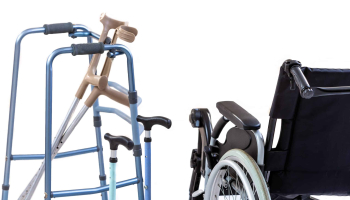For PD patients that we deal with at our centre, there is always the question on what would be better: a walker with wheels or just a standard walker without wheels.
Well, we will explore on the advantages of each and tell you what you should go for.
But before that, let us look at the why one would go for any of the walkers in the first case.
- You want your patient to have stability while walking around. That is if, they are able to walk. If not, then you would better go for a motorized electric scooter.
- You want the patient to have some sense of independence such that they can do basic tasks on their own such as going to the bathroom or going out to bask in the sun without having to request for help.
- For patients with gait freezing, a walker would help them from falls plus provide some sensory cues to stop the freezing especially when it comes with laser lights and sound beeps.
Having looked at reasons why one needs a walker, we can now explore some of the factors that would make one go for either a wheeled or standard walker while leaving out the other. Let’s cut to the chase.
- Weight of the walker
One big factor that you need to consider is the weight of the walker. Studies have shown that weighted walkers are better at giving a patient balance and stability. If you compare the standard walker with the wheeled walker, you will find that one with wheels tend to be heavier and will thus be better in giving the patient more balance and stability as they walk around.
2. Laser cues and beeps
With wheeled walkers, I have seen most installed with sensory cues such as laser lights and auditory beeps. These cues help in prompting the patient to make a move when they have moments of gait freezing.
3. Rests during walk
For patients who tire easily or those who want to make long laps on their walkers, they would definitely need a walker that has a seat and maybe a storage pouch. With these two, they can take rests during their walks. I have only seen such accessories in wheeled walkers but never in standard walkers.
Therefore, the wheeled walker again beats the standard walker if the patient wants to take rests during the walk or if they have some water, snacks or fruits that they need to carry in their walker storage pouches.
4. Flexibility of walker in corners and narrow passageways
Standard walkers tend to be extra thin such that they can easily negotiate through corners and narrow passageways in the house. There are also some nice, wheeled walkers such as the ustep walker which can go through narrow paths and also turn with ease when walking with it.
5. Affordability
It goes without saying that a standard walker will be less expensive as compared to the wheeled walker. This is because it has less accessories and is lightweight. So, if you are short on money, you might have to go with the standard non wheeled walker.
6. Risk of accidental falls and stability
One main disadvantage about wheeled walkers is that patients might record more falls especially if the braking system is not the reversible type. Picture this, a patient has gone to the washroom with their wheeled walker and placed it in front of themselves. As they rise to go back to other businesses, they will hold the wheeled walker and if it does not have a reversible braking system, it will move unexpectedly causing the patient to fall.
With a standard walker, accidents are minimal since it is not likely to propel one forward. Especially when it has been installed with good rubber stoppers at the bottom.
7. Speed in Walking
For Parkinson’s patients who have gait freezing episodes, all walkers will slow them somehow. But the standard walker is the least in slowing the patient’s speed of walking around.
Verdict
Our verdict is that the wheeled walker is way better than the standard walker if you are to consider the weight, stability, rests to patients as well as ability to carry something with it. It gets even better if it has a reversible braking system plus laser cues and sound beeps. Though it will cost more, it offers true value for the money.







